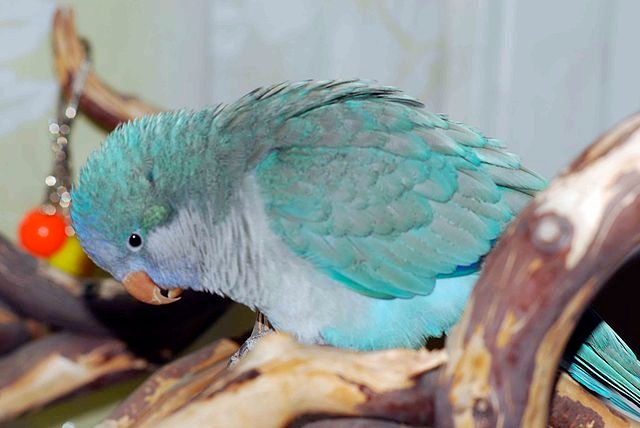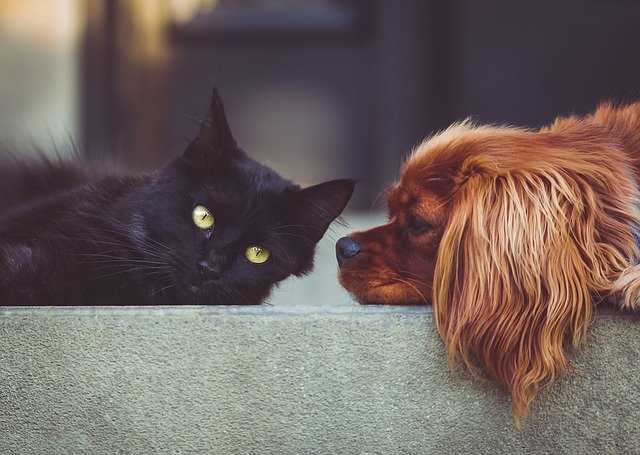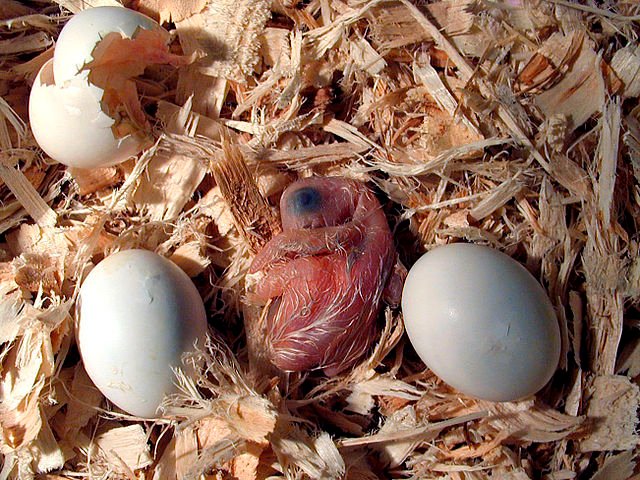Quaker Parrot: Nature’s Beautiful Creature
Over the years, people have chosen Quakers over other parrots, not only because they are the equivalent of a large parrot in that small body, but also because their beauty is unmatched. And acting true to their experimenting nature, humans thought of trying something creative with this little birdie too by enhancing his beauty. Just a little thought and the breeders created a whole new army of beautiful Quakers with varied colors.
The grayish color on their feathers and breast have earned them another name “Grey-breasted parakeet’. And these are not the only two colors they flaunt. They are a walking canvas with green plumage, yellow abdomen, soft orange beak, and blue color sprinkled on his tail. Courtesies this color riot, they are our favorite pet to bring home.
Though the basic personality traits stay the same the breeding brings few changes here and there in their original character. Here is everything that you need to know about these little birdies and their varied colors. But let’s first crack the science, in a simpler sense, behind achieving these eye-catching colors.
The original green Quakers:
To understand the appearance of blue color in Quakers, let us first discuss what colors our eyes can see. Humans can distinguish between all the colors available in the white light. When an object appears green to us, it is absorbing all other colors of the white light and reflecting green.

In Quaker parrots, two genes play a major role in deciding their color structure. A pigment gene gives yellow color to their feathers and a structural gene creates a prism-like structure of their feathers reflecting blue light from the feathers. This combination of blue light and yellow-colored feathers makes him appear green.
How did the color mutation start?
Have you ever wondered from where did the process of color mutation start in Quaker Parrots? The answer to this question takes us to the 1950s. The first-ever blue Quaker parrot was seen in Belgium in the wild. The Duke of Bedford, a popular bird raiser of the time, brought a few pairs from the wild. All the blue breed originated from this stock of Quakers kept by the Duke.
Later in the 1980s, a few breeders from the United States sourced them to their country. With their decades of research, they concluded that color mutations can be carried out on Quakers for almost all the colors of Cockatiels. This marked the beginning of a new color chart for our little birdies.
The breeders from the US started breeding Quakers with color mutation after completing the initial color testing with blue Quakers. These cross-breed offsprings were shipped over to other breeders of the states. The demand for blue Quakers sky-rocketed all over the country. Since they were a new breed, everyone wanted to flaunt them at their gatherings. The pet lovers wanted to have their hands on them to spend time with a new breed and know it better. Due to an explosion in demand, the pet shops and aviaries of all sizes sourced them from big breeders. This is how blue Quakers became abundant in the US.
The basics of color mutation:
The presence of two color pigments in different ratios decides the color of the Quaker. The blue color appears more prominently when the pigment gene is less prevalent. The yellow color appears more prominently with the structure gene less prevalent. A pallid Quaker is born with both the genes present minimally and an albino Quaker is born with both genes absent altogether.
How that color changes:
The chromosomes in the birds are arranged in pairs and they are then passed onto the offspring independently. To get the color of the feathers, the offspring inherits one gene each from mother Quaker and father Quaker. But to get the body color, there are two ways of gene inheritance:
Dominant Mutation Technique
In the dominant mutation, to get the desired color, the offspring will inherit only one color gene from either of the parents. That will decide the color of the young one. The main colors of Quakers through dominant mutation are;
1.) Grey-green (Europa): This mutation was first observed in the Czech Republic towards the end of the nineties and soon it became extremely famous all over Europe. The birds born under this mutation has greyish color. These birds should not be confused with the Olive mutation which falls under the Dark Faktor dominant mutation.
In this mutation, the color of the plumage becomes dark green from the usual bright green. The color is quite dull as if Quaker has been dipped into petroleum and taken out. The tail also changes its color. But the claws, legs, beak, and eyes don’t change their color.
2.) Dark Faktor: This mutation was also achieved in the Czech Republic around the same time when the Grey-green Europa was observed and is quite similar looking. That is why only experts could tell the difference between both. The green color of their plumage changes to a grey one but the grey is not that dull and prominent. This makes them look lighter than the grey-green Quaker. For this reason, they are called Olive mutation.
Recessive Mutation Technique
In the recessive mutation, to get the desired color, the offspring should get one gene each from both parents alike. And this is further categorized as:
Autosomal Recessive Mutation– Varied colors have been achieved following this pattern of recessive mutation. They are:
1.) Blue: The Blue Quaker is the second most easily available Quaker color, after the natural green one. They are slightly smaller in size than the original green ones. Blue Quaker is a very basic mutation to achieve scientifically and was created in the 1840s in Belgium by Mr. MJ Bruyneel. The synthesis of the green color of the Quaker is put under controlled conditions. The blue Quakers’ paws, claws, beaks, and eye color are not muted, but the color of his plumage changes to blue from green; and the color of his breast changes to silver from the original grey. Also, his feathers get a blue tint which can be noticed from the 16th day of their birth. Their easy availability across the globe has made them the cheapest color mutation available.

2.) Parablue: This mutation is believed to have come into existence around 1995 in Belgium and found its way to the Netherlands, Great Britain, and Canada in 1999 and into the Czech Republic, the USA, and Poland in 2011. There are two types of mutations in it- the turquoise and aqua. They both are called Parablue mutation due to their origin in the blue mutation. But there are slight differences between both:
(i) Turquoise Mutation – This is sometimes also referred to as a blue-pastel mutation. The reduction of the original green color is only up to 20%. The next major difference which will help you identify the turquoise mutation is the sprinkling of color, which has an irregular pattern. In this mutation, the Quaker has blue-green stains on the plumage with green being very dominant. Turquoise Quaker will be much greener.
(ii) Aqua Mutation – In Australia, this mutation is also known as ‘sea-green’ mutation. The reduction of the green color is 50%. This makes this mutation a lot bluer. Also, the color sprinkling pattern on the plumage is uniform throughout and not in patches like the turquoise one.
3.) Lutino: This mutation of Quaker can be achieved both by autosomal as well as by sex-linked recessive inheritance. The results are almost the same. The Lutino mutation was attempted by a zoo in Berlin in the 1840s but it soon disappeared. It was again attempted in the 1870s in Europe and became known as it debuted in America in 1995.
It is considered as one of the most beautiful color mutations. In this, the green color is replaced with yellow. And the grey color of the breast gets the yellow-white creamish color. The eye color becomes red but the color of the beak stays the same.
4.) Pied: This color mutation involves less dark-dye on the plumage and the birds’ body. The claws and paws are also yellowish. In the USA, some Quakers of yellow patches on plumage have also been spotted but the reports of their actual mutation have not been backed by this breeding pattern. But such a mutation is not impossible to achieve. The pied Quaker is a rare breed and is quite expensive.
5.) Fallow: This bird holds the same gene as of Lutino mutation. The production of a dark green color is stopped to a large extent. Due to this, the entire plumage of the bird gets a very light color tone. The claws and paws also get lightened. It seems as if the green bird has been sprinkled with the yellow mist all over. The offspring born from this mutation has bright red eyes, just like Lutino’s, which gets darker with age. The color becomes so dark until adulthood that it almost looks black. But the color of the beak remains unchanged.
6.) Grey-green (USA): This grey-green mutation is not the same as grey-green Europa mutation. Firstly, it follows a different method of inheritance,i.e., Autosomal Recessive mutation. Secondly, the major difference is the color. The American grey-green Quaker has a much darker green color on the plumage and feathers than the grey-green Europa mutation, which has an olive green color tone. It was first developed by Bob Nelson in 2001 in Oregon, who got hold of few wild Quaker parrots from their colony in Florida.
Sex-linked Recessive Mutation – The colors created by this way of mutations are :
1.) Lutino: As discussed, this one is achieved through a sex-linked recessive technique. This mutation is almost similar to the one achieved through the Autosomal technique discussed above. The only difference is the yellow color is slightly lighter with this technique.
2.) Pallid: The pallid color mutation was first achieved in Europe in the 1980s. The Quaker, in this mutation, gets a soft yellow coating on his bright green body. Paws, claws, plumage and the breast area, all get a slightly lighter tone. The eye color is the darkest red. But the color of the beak stays the same. The Pallid mutation should not be confused with the Cinnamon one.
3.) Opaline: This mutation is the latest one, having achieved in 2001 only in Europe by Mr. Xavier Favoreu. Soon it spread to other parts of Europe like Germany, Netherlands, Belgium, Italy and more. This is quite an expensive mutation. This mutation is quite rare which makes it extremely expensive to get your hands on. In this mutation, the green color is not reduced but is only redistributed, resulting in a color that seems a mixture of green and yellow with strong tinges of yellow. The color of the beak, paws, claws, and eyes stays the same. Even the feather color remains unchanged except for a whitish line which can be seen when the wings are unfolded.
4.) Cinnamon: As per the records, the Cinnamon Quaker Parrot mutation was achieved in the 1980s. But that is untrue as it was a Pallid mutation. The actual authentic Cinnamon mutations were imported in 2002 from Argentina. The renowned Spanish breeder Mr. Xavier Favoreu brought in the two females. The Cinnamon mutation has a little cinnamon coating over the usual green color. But the color of the feathers changes considerably from dark-blue or green color to Cinnamon. The claws and paws get lightened and the eye color is dark plum. But the color of the beak stays the same.
The colorful Quakers:
If you think that is all the mutations we have, you are mistaken. Quaker lovers have achieved numerous other color mutations. Many people claim that they have seen Quakers in colors not known to mankind. Such color mutations include yellow-headed mutation, yellow face mutation, dark-eyed white, dark-eyed green, cremino, cobalt-blue, blue pallid opaline, blue pallid, blue opaline, green pallid opaline, green opaline, green pallid, grey-blue, grey-blue opaline, grey-green, grey-blue pallid, mauve, grey-green opaline, turquoise, turquoise pallid and many more. The possibilities are endless.
Today, even small breeders are experimenting with creating a uniquely colored Quaker to attract more buyers. Pet shop owners try to source them in varied colors to offer more options to their customers. Quaker Color has become an important factor in making a purchase decision for bird lovers. And numerous color mutations can still be formed. The breeders are only a gene combination away.
Quaker Parrot’s Color Mutation Chart :

The conclusion from a pet lover perspective 🙂
Humans love colors as they are appealing to our eyes and provide us with happiness. We tend to get attracted to a specific color depending on our moods. When nature does not provide us with enough options, we create them with the resources available to us. To add to the variety of natural colors of Quaker parrots, we created a whole new palette for our favorite feathered friend. Making our world beautiful is one thing but judging the creatures based on their beauty is going off-the-track.
If you are planning to bring a new Quaker parrot to your home, please don’t make a decision based just on his color. Physical appearances are just our perceptions about others. Outer beauty can never match the inner qualities of a being. A supremely beautiful-looking Quaker is not a guarantee to get the right companion. But, if you listen to your inner-feeling while choosing your new family member or rather, let your Quaker choose you, you are more likely to find the one made just for you. An excellent bond will develop between you two, no matter what color he is.
If you want to buy Cage for your parrot Check our Amazon affiliate link please 🙂
Some Suggestions on What to read next on our website:
Read more About Quaker parrot Gender differences –
https://parrotquaker.com/quaker-parrot-gender-differences/
or read more about keeping Quaker in Apartment –
https://parrotquaker.com/quaker-parrot-in-an-apartment/




